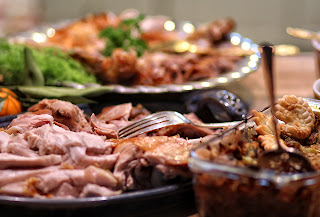However, once in a while I'll break down and bake something - especially if it is for a catering gig. In this case I was creating a Moroccan-themed dinner for 40 people. I wanted one of the desserts to be an easy, pop-in-your mouth cookie with a nod to Morocco.
After some scouring on the internet, I found this recipe, which I altered to fit my needs.
These cookies were really good. They are what I would term 'adult cookies' because they are not very sweet and combine interesting flavors not found in something like - say - an Oreo. Not that there's anything wrong with Oreos.
First a Word about Tahini
Tahini is sesame butter. It is made from raw sesame seeds and has a nutty flavor. It comes unsalted and is not particularly yummy on its own. There are many, many delicious things you can make with tahini, though. And one of these days, when I have nothing else to do than write in my blog, I will tell you all about them!
When you buy tahini (and you can get it most anywhere now - grocery store, Middle Eastern deli, WalMart, etc.) - the oil of the sesame seeds will have separated and needs to be stirred in. This can take some effort because usually there is a thick sediment at the bottom of the container that is resistant to being incorporated. However, with persistence you will succeed - just like in life.
Once you refrigerate the mixed-up tahini, it won't separate again. It will keep for ever and a day in the fridge.
And now the recipe
3/4 cup (one and a half sticks) unsalted butter, softened
1/2 cup tahini
1 1/4 cup packed dark brown sugar
1/2 tsp salt
2 cups flour + extra for dates
8 Medjool dates, chopped into small pieces
Handful of raw sesame seeds
Place dates in freezer so they will be easier to chop. (Otherwise, they’ll just stick to each other and to the knife.)
You'll need aluminum foil.
Once you are ready to bake, preheat the oven to 375 degrees Fahrenheit. Lightly butter two cookie sheets or half-sheet pans (whatever you have).
Directions
Blend butter and tahini with an electric mixer. Add sugar and salt and blend until smooth. Add flour and blend again. Take the dates out of the freezer, remove pits and roughly chop. Toss with a tablespoon or two of flour so they do not stick to each other and will be distributed evenly in batter. Mix into batter with a spoon.
Divide the batter into two portions. Take one portion and squish it into a sausage form on a length of aluminum foil - about 2 inches in diameter. Take your time, since the batter will be soft. The roll doesn't have to be super smooth.
Sprinkle some sesame seeds along and on top of the roll of dough. Using the aluminum foil, roll the dough so that the sesame seeds coat the outside of the dough. Finish wrapping the dough sausage in foil and place into the freezer. Repeat with the second portion of dough.
Your aluminum-wrapped dough sausages will be about 18" long.
Freeze for an hour or longer. You can make the dough sausages way ahead if you want.
Time to Bake!
Preheat oven to 375 degrees Fahrenheit. Lightly butter your cookie sheet (or half-sheet pan). Or you can use parchment - but that's usually fussy.
Unfurl the aluminum foil from the dough and cut the dough in 1/2-3/4" slices. Try to get all the slices about the same thickness, so they will cook evenly.
Place on the baking sheet, leaving about an inch between each cookie. Bake for about 15 minutes or until brown on the bottom.
While the first batch of cookies is baking, prepare the second baking sheet.
By the way... you can eat this dough raw - it has no eggs - and it is crazy good. You might just save one of those dough sausages for late night trips to the fridge.
When the cookies come out of the oven, allow them to set for 5 minutes. Then remove with a thin spatula onto a cookie rack and cool completely before eating. These cookies will keep in a tin for a week or so. They benefit from dry conditions. If you live in the tropics like I do, store them in a plastic zipper bag in the freezer. Thaw briefly before serving.




































